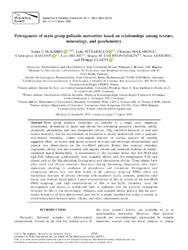Petrogenesis of main group pallasite meteorites based on relationships among texture, mineralogy, and geochemistry
Makarona, Christina
Hecht, Lutz
Chernonozhkin, Stepan M.
Goderis, Steven
DOI: https://doi.org/10.1111/maps.13392
Persistent URL: http://resolver.sub.uni-goettingen.de/purl?gldocs-11858/8545
Persistent URL: http://resolver.sub.uni-goettingen.de/purl?gldocs-11858/8545
McKibbin, Seann J.; Pittarello, Lidia; Makarona, Christina; Hamann, Christopher; Hecht, Lutz; Chernonozhkin, Stepan M.; Goderis, Steven; Claeys, Philippe, 2019: Petrogenesis of main group pallasite meteorites based on relationships among texture, mineralogy, and geochemistry. In: Meteoritics & Planetary Science, Band 54, 11: 2814 - 2844, DOI: 10.1111/maps.13392.
 |
Dokument öffnen: |
Main group pallasite meteorites are samples of a single early magmatic planetesimal, dominated by metal and olivine but containing accessory chromite, sulfide, phosphide, phosphates, and rare phosphoran olivine. They represent mixtures of core and mantle materials, but the environment of formation is poorly understood, with a quiescent core–mantle boundary, violent core–mantle mixture, or surface mixture all recently suggested. Here, we review main group pallasite data sets and petrologic characteristics, and present new observations on the low‐MnO pallasite Brahin that contains abundant fragmental olivine, but also rounded and angular olivine and potential evidence of sulfide–phosphide liquid immiscibility. A reassessment of the literature shows that low‐MnO and high‐FeO subgroups preferentially host rounded olivine and low‐temperature P2O5‐rich phases such as the Mg‐phosphate farringtonite and phosphoran olivine. These phases form after metal and silicate reservoirs back‐react during decreasing temperature after initial separation, resulting in oxidation of phosphorus and chromium. Farringtonite and phosphoran olivine have not been found in the common subgroup PMG, which are mechanical mixtures of olivine, chromite with moderate Al2O3 contents, primitive solid metal, and evolved liquid metal. Lower concentrations of Mn in olivine of the low‐MnO PMG subgroup, and high concentrations of Mn in low‐Al2O3 chromites, trace the development and escape of sulfide‐rich melt in pallasites and the partially chalcophile behavior for Mn in this environment. Pallasites with rounded olivine indicate that the core–mantle boundary of their planetesimal may not be a simple interface but rather a volume in which interactions between metal, silicate, and other components occur.
Statistik:
ZugriffsstatistikSammlung:
This is an open access article under the terms of the Creative Commons Attribution License, which permits use, distribution and reproduction in any medium, provided the original work is properly cited.

